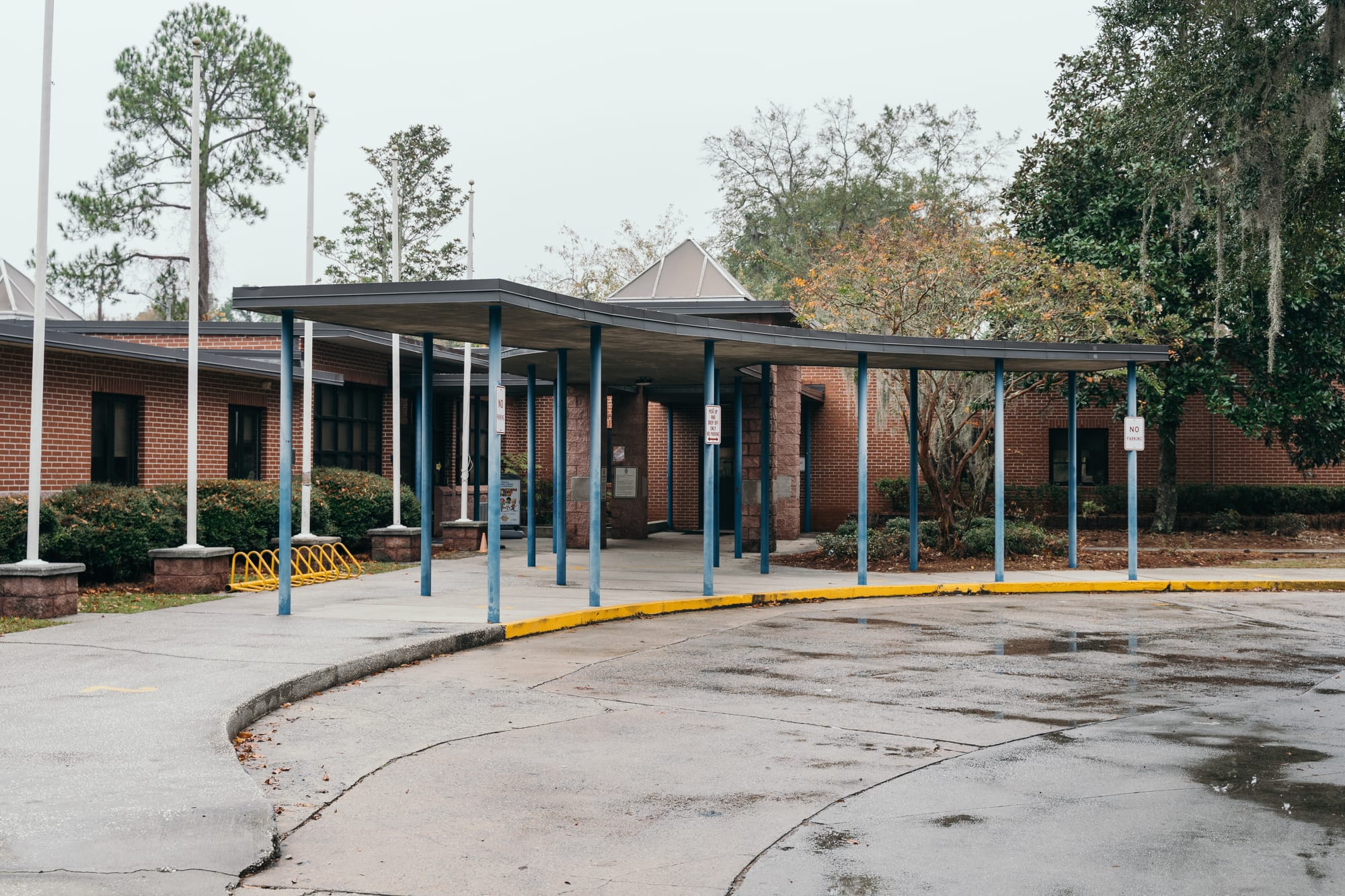By Nell Shellman | Photos by Marsalis Eason
“THIS AREA is not The Landings or Wilmington Island. The people that live here—we can’t afford a bunch of things like the other communities,” Francisco Aparicio said, sitting under a park shelter by Salt Creek on a rainy day with a parade of concerns crossing his face.
“We got no choice, and they try to take away the only good thing that we have over here. It held the community, because education is the main key of any kind of society, and when you make it hard to get access, where are we going to end?”
Aparicio’s son is a fourth grade student at Gould Elementary School, and like all students at the SCCPSS site just off Ogeechee Road a stone's throw from the marshes of the Little Ogeechee, he could lose the community he has grown up in.
The school is slated to close next school year as a part of Savannah Chatham County Public Schools Superintendent Denise Watts’ new facilities plan, which was introduced to both the school board and general public in an informal board meeting on November 1.
In preparation for the plan’s introduction, parents had been notified of possible changes at the end of October. Students and staff would be scattered among three other elementary schools: Haven, Butler, and New Hampstead, with additional administrative placement at the Gould-Mercer-Groves—or GMG—K-12 site slated to open next year in Garden City.
According to Watts’ presentation, 337 students would go to Butler, 92 to Haven, and 394 to new Hampstead. The presentation did not state where displaced teachers and staff would be moved.
Originally, students from Gould elementary were all planned to relocate to the GMG site, but this new plan would save the district almost half a million dollars over the next two school years. The current Gould Elementary site will become the district’s centralized technology center for the Data and Accountability department.
This plan currently awaits board approval. Meanwhile, parents were only addressed directly by SCCPSS district staff concerning the move at a meeting at Beach High School on November 4. The meeting was held at 11 a.m. in the morning and started late.
The plan is designed to both save the district $3.5 million and prepare the district for future changes in resource allocation, notably with SCCPSS anticipating an influx of students after the Hyundai plant opens. However, this move and its speed leaves some members of the community like Aparicio feeling like the carpet has been pulled out from under them.

Stakes are high because of Gould’s success. According to Christina Magaña, director of operations and outreach for Migrant Equity Southeast, the community at Gould has a special bond.
“What makes Gould Elementary unique is really the sense of community that they have there,” she said. “You can tell how the teachers are reacting, how the parents are reacting, how the students are reacting. And the district calls this a model school for a reason because they have such a good relationship with their students and their parents. This is a community school.”
“I believe close to 300 students walk to school, and there's also an excellent special needs program and amazing staff that run that,” Magaña continued. “That's what is really disappointing, that the students are going to be potentially losing these important relationships they have with their teachers and staff at Gould.”
Magaña also noted that this change of plans was the opposite of previous messages teachers and staff had received about the school.
“The parents, students and teachers really wanted to fight for Gould Elementary to stay open. The staff at that location have been told for many years that a new building would be built on the facility. The actual location is about six acres, and that is more space than the most recent school that they have built all throughout the district.”
That community school atmosphere—a place where students can walk to a haven that offers specialized care—also was a sticking point for Aparicio. The district ongoing transportation worker shortage casts doubt on the ability of buses to get students who currently walk to their new sites.
“And most of these parents don't got cars. Sometimes they got to take the public bus to get to the job, or sometimes they got to work for somebody who picks them up from the house,” he said. “These guys have no way to get to their kids if they're moved somewhere else. Nobody's thinking about those guys, but this is real people, and then you do not want to help and make it worse for them.”
“There’s a bunch of single moms, and they can’t afford a car. They walk their kids in the morning, and they come for their kids in the afternoon.”
The board is expected to make decisions about the move to shutter Gould along with other parts of the plan at the December 6 board meeting. In the meantime, Aparicio says others aren’t quite certain what they are supposed to do if the plan is enacted. His family has been at Gould before his son was even born. Before Aparicio’s son attended Gould, his older daughter did, so the Gould staff have known his son since he was an infant.
“I saw a teacher crying the other day, because she's so sad that this is going to happen,” he said. “Because this is more than just only the school—it’s a community, and it’s making a difference.”
“I think it is making a difference for these families that are immigrants, and they're welcoming them compared to other schools that don't really care.”
Gould’s status as a model school highlights its success with demographics that schools traditionally struggle with. Migrant Equity Southeast’s Executive Director Daniela Rodriguez noted that a Gould high school community forum on November 29 the school’s student population was 42.2 percent Hispanic, 48.3 percent economically disadvantaged, and 25.8 percent English language learners. According to Magaña, an additional 13.3 percent of the student population has learning disabilities.
“If you are changing things around, why choose the schools that have a high percentage of English as a second language students to be the first to go through changes?” Rodriguez asked in the community meeting. During the meeting, Gould teacher Chantel Brown noted the district made assurances that staff would be allowed to transition without problem to the new building prior to the current plan, but that this was no longer true. Board of Education representatives were not present at the meeting, which parent Kelly Graham pointed out in her address to the crowd.

The nonprofit Migrant Equity Southeast focuses on immigrant rights locally, and representatives have spoken out in recent school board meetings about a pattern of district choices that disproportionately impact the local Hispanic community. MESE has intervened on this basis.
“As an organization, we're just here to support what the community is asking, and they are asking us to save Gould,” Magaña said.
At the beginning of the year, the district moved English as second language learners from the overcrowded Groves site to other high schools throughout the district, some of which do not have enough ESOL staff to absorb them, technology for them to use, or even enough spaces in classrooms to allow them to take core classes. Concerned parents and representatives from MESE have spoken at school board meetings since September about the controversial move.
According to Magaña, those changes also were made with little parent notice or warning. Similar to Gould’s meeting at Beach the message itself was also poorly conveyed.
“But yes, it is indeed similar and we are concerned, because for Groves High School, changes happened one month into the school year, with two weeks' notice. There was a committee meeting scheduled to happen in which the parents would be informed of what's going on with the changes,” she said. “However, we had a hurricane happen, and instead of pushing it back, or rescheduling it for a later date, they moved the parent meeting up one day and made it virtual while everyone is preparing for an evacuation. The appropriate thing would have been to delay this change so that parents and students have more time to adjust to the very drastic changes.”
Also much like Gould, there remained questions about transportation.
“Some of the initial concerns that happened within Groves High School with students being moved was the lack of clarity as far as transportation. Students were told on their last day of school to meet in the cafeteria to find out what their transportation plan would be. However, some students couldn't stay because they had to go catch the bus.”
The resulting situation was just one field that confusion grew in for the move. Now parents fear that a similar scenario is unfolding at Gould Elementary, and concerns over whether these schools will be able to absorb the students remain at the front of Aparicio’s mind.
“Those schools already have their problems, and now they're going to have more kids,” he said through an interpreter. “And now there’s going to be even more problems. How are they going to fix that transportation and internal problems with literacy?”
Those problem are difficult to solve when communication is not present. Magaña noted that a throughline with the district’s moves on both schools is that the kind of communication non-English speaking parents need is simply not there.
“I would say that there needs to be a more consistent consideration of clear communication with parents whose first language is not English,” she said. “Notices may be sent out but sometimes notices are just sent out in English, or just 24 hours in advance. Parents at both schools are frustrated at the lack of consideration of language accessibility and communication, and consideration of the parents' input. Having a meeting one week before changes or one month before changes is sometimes not sufficient if it's not properly communicated in the language that is preferred to the parents.”
She also noted that when interpreters have been present to help, they have not been properly prepared. Parents still walk away without necessary information that simply cannot be found on the website, as in the case of the November 4 meeting. Information asking for parent feedback using surveys literally could not be understood by parents. She said as a result, parent voices could not even be heard.
Magaña made it clear that the problem was not so much change itself, so much as an implementation that “It’s a matter of a set plan, a set staff.”
As for Aparicio, he just wants the district to fix issues with the current site—mold and a kitchen update—so the community can live on.
“I really wish that these people would leave Gould for new generations here.”
Special thanks to Migrant Equity Southeast for providing interpretation services. Rachael Flora contributed to this report.

